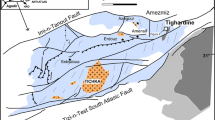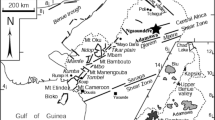Summary
The Miocene volcanic suite of Sierra de Gata (Betic Cordillera) is composed of dacites, rhyodacites and rhyolites, besides basaltic andesites and andesites. The latter are very fresh and are the least fractionated rock types; thus they have been investigated in order to put some constraints on the genetic interpretation of the volcanic sequence. These rocks are composed of plagioclase, orthopyroxene, clinopyroxene and magnetite both as phenocrysts and in the groundmass. Olivine and ilmenite occur occasionally. The andesites exhibit “orogenic” chemical features. They are characterized by very low Ni, Co and Cr contents and show negative Eu anomalies, which support fractionation of mafic phases and plagioclase at depth. The petrogenesis of the andesites, however, cannot be related simply to fractionation processes of a single mafic magma since the lack of good interelemental correlations, the scattering of Sr-isotope ratios and the isotope disequilibrium between the phases conflict with such a simple mechanism. A model which can better explain the petrogenesis of the analyzed andesites considers the intervention of different mafic melts, generated in a heterogeneous mantle and characterized by different chemical and isotopic compositions, which fractionated at depth and concomitantly interacted significantly with the continental crust.
Zusammenfassung
Die miozäne Vulkanitabfolge der Sierra de Gata (Betische Kordillere) wird von Daciten, Rhyodaciten, Rhyoliten sowie basaltischen Andesiten and Andesiten aufgebaut, letztere sind in einem guten Erhaltungszustand and zeigen die geringste Fraktionierung. Sie wurden daher genauer untersucht, um Aussagen über die Genese dieser Vulkanite machen zu können.
Phenokrysten und Grundmasse bestehen aus Plagioklas, Orthopyroxen, Klinopyroxen und Magnetit. Manchmal kommen Olivin und Ilmenit hinzu. Die Geochemie der Andesite folgt typisch “orogenen” Trends. Sie sind durch sehr niedrige Ni-, Co- und Cr-Gehalte und negative Eu-Anomalien charakterisiert; dies belegt eine Fraktionierung der mafischen Gemengteile und des Plagioklases in der Tiefe. Die petrogenetische Entwicklung der Andesite kann allerdings nicht einfach mit Fraktionierungsprozessen eines einzigen mafischen Magmas erklärt werden. Das Fehlen von Element-Korrelationen, das starke Streuen der Sr-Isotopenverhältnisse und das Isotopenungleichgewicht zwischen den einzelnen Mineralphasen stehen in Widerspruch zu einem derartigen einfachen Modell. Ein Modell, das die Petrogenese der untersuchten Andesite besser erklärt, zieht die Beteiligung verschiedener mafischen Schmelzen-sie bildeten sich in einem heterogenen Mantel und sind durch Unterschiede im Chemismus und ihrer Isotopenzusammensetzung charakterisiert—in Betracht. Dabei kam es zu Fraktionierung dieser Magmen in der Tiefe und zu beträchtlichen Reaktionen mit kontinentalem Krustenmaterial.
Similar content being viewed by others
References
Arculus RJ, Powell R (1986) Source component mixing in the region of arc magma generation. J Geophys Res 91: 5913–5926
Bellon H (1976) Séries magmatiques néogènes et quaternaires du pourtour de la Méditerranée Occidentale, comparées dans leur cadre géochronometrique. Implicationnes géodynamiques. Thèse de Sciences, Université Orsay, Paris, 367 pp
——,Bordet P, Montenat C (1983) Chronologie du magmatisme Néogène des Cordillères Bétiques (Espagne Meridionale). Bull Soc Geol France 25: 205–217
Bordet H (1985) Le volcanisme miocène des Sierras de Gata et de Carboneras. Doc et Travaux Institute Géol Albert De Lapparent, Paris 8, 70 pp
Bordet P, Esquevin J, De Larouziére FD (1982) Sur l'âge tortonien de certains granitoïdes inclus dans les conglomérates miocènes de l'Espagne du Sud-Est. C R Acad Sci Paris 295: 483–486
——,De Larouzière FD (1983) Particularites géochimiques des volcanites miocènes des Sierras de Gata et de Carboneras (Almeria, SE Espagne). C R Acad Sci Paris 296, 449–452
Capedri S, Venturelli G, Salvioli Mariani E, Crawford AJ, Barbieri M (1989) Upper mantle xenoliths and megacrysts in the alkali basalt of Tallante, Southeastern Spain. European J Mineral 1: 685–699
Chopin C (1984) Coesite and pure pyrope in high-grade blueschists of the Western Alps: a first record and some consequences. Contrib Mineral Petrol 86: 107–118
De Larouzière FD, Bolze J, Bordet P, Hernandez J, Montenat C, Ott d'Estevou P (1988) The betic segment of the lithospheric Trans-Alboran shear zone during the Late Miocene. Tectonophysics 152: 41–52
De Paolo DJ (1981) Trace element and isotopic effect of combined wall rock assimilation and fractional crystallization. Earth Planet Sci Lett 53: 189–202
Di Battistini G, Toscani L, Iaccarino S, Villa IM (1987) K/Ar age and the geological setting of talc-alkaline volcanic rocks from Sierra de Gata, SE Spain. N Jb Miner Mh H8: 369–383
Ewart A (1982) The mineralogy and petrology of Tertiary-Recent orogenic volcanic rocks: with special reference to the andesitec-basaltic compositional range. In:Thorpe RS (Ed) Andesites. Wiley, New York, pp 25–95
Faure G (1977) Principles of isotopic geology. Wiley, New York, 464 pp
Fernandez Soler JM (1987) Analisis e interpretation de los materiales volcanisas del Cerro de Los Frailes (Cabo de Gata, Almeria). Estudios Geol, Madrid 43: 359–366
Fuster JM, Ibarrola E, Martin J (1967) Las andesites piroxenicas de la Mesa de Roldan (Almeria, SE de España). Estudios Geol, Madrid 23:1–13
Hawkesworth CJ, Norry MJ, Roddick JC, Baker PE, Francis PW, Thorpe RS (1979)143Nd/144Nd,87Sr/86Sr, and incompatible element variations in cale-alkaline andesites and plateau lavas from South America. Earth Planet Sci Lett 42: 45–57
Hickey RL, Frey FA, Gerlach DC, Lopez Escobar L (1986) Multiple sources for basaltic arc rocks from the southern volcanic zone of the Andes (34°–41° S): trace element and isotopic evidence for contributions from subducted oceanic crust, mantle, and continental crust. J Geophys Res 91: 5963–5983
Kouchi A, Sanagawa I (1985) A model for mixing basaltic and dacitic magmas as deduced from experimental data. Contrib Mineral Petrol 89: 17–23
Leon C (1967) Las formaciones volcanisas del Cerro de Los Lobos (Almeria, SE de España). Estudios Geol, Madrid 23:15–28
Lopez Ruiz J, Rodriguez Badiola (1980) La region volcanisa Neogena del sureste de España. Estudios Geol, Madrid 36: 5–63
Munksgaard NC (1984) High δ18O and possible pre-compositional Rb-Sr isochrone in cordierite-bearing Neogene volcanics from SE Spain. Contrib Mineral Petrol 87: 351–358
Nobel FA, Andriessen PAM, Hebeda EH, Priem HNA, Rondeel HE (1981) Isotopic dating of the post-Alpine Neogene volcanics in the Betic Cordilleras, Southern Spain. Geol Mijnbouw 60: 209–214
Paez Carrion A, Sanchez Soria.P (1965) Vulcanologia del Cabo de Gata, entre San Jose y Vela Blanca. Estudios Geol Madrid 21: 223–246
Powell R (1984) Inversion of the assimilation and fractional crystallization (AFC) equations; characterization of contaminants from isotope and trace element relationships in volcanic suites. J Geol Soc London 141: 447–452
Puga E (1980) Hypothèses sur is genèse des magmatismes calcoalcalins, intraorogénique et postorogénique alpins dans Les Cordillères Bétiques. Bull Soc Géol France 22:243–250
Pushkar O, McBirney AR, Kudo AM (1972) The isotopic composition of strontium in Central American ignimbrites. Bull Volcanol 35: 265–294
Sanchez Cela V (1968) Estudio petrologico de las sucessiones volcanisas del sector central de la formation del Cabo de Gata (Almeria). Estudios Geolog, Madrid 24:1–38
Schreyer W Massonne H-J, Chopin C (1987) Continental crust subducted to depth near 100 km: implications for magma and fluids genesis in collision zones. In:Mysen BO (ed) Magmatic processes: physicochemical principles. The Geoch Sac, Special Publ No 1, pp 155–163
Thorpe RS, Francis PW, O'Callaghan (1984) Relative roles of source composition, fractional crystallization and crustal contamination in the petrogenesis of Andean volcanic rocks. Phil Trans R Soc London A310: 675–692
Torres Roldan RL, Poli G, Peccerillo A (1986) An Early Miocene arc-tholeiitic magmatic dyke event from the Alboran Sea. Evidence for pre-collisional subduction and back-arc crustal extension in the westernmost Mediterranean. Geot Rundsch 75/1: 219–234
Venturelli G, Thorpe RS, Dal Piaz GV, Del Moro A, Potts PJ (1984) Petrogenesis of calcalkaline, shoshonitic and associated Oligocene volcanic rocks from the Northwestern Alps, Italy. Contrib Mineral Petrol 86: 209–220
——,Salvioli Mariani E, Foley SF, Capedri S, Crawford JA (1988) Petrogenesis and conditions of crystallization of Spanish lamproitic rocks. Canad Mineral 26: 67–79
Winchester JA, Floyd PA (1977) Geochemical discrimination of different magma series and their differentiation products. Chem Geol 20: 325–343
Wood DA, Joron J-L, Treuil M (1979) A re-appraisal of the use of trace elements to classify and discriminate between magma series erupted in different tectonic settings. Earth Planet Sci Lett 45: 326–336
Zeck HP (1970) An erupted migmatite at the Cerro de Hoyazo, SE Spain. Contrib Mineral Petrol 26: 225–246
Author information
Authors and Affiliations
Additional information
With 5 Figures
Rights and permissions
About this article
Cite this article
Toscani, L., Venturelli, G., Barbieri, M. et al. Geochemistry and petrogenesis of two-Pyroxene andesites from Sierra de Gata (SE Spain). Mineralogy and Petrology 41, 199–213 (1990). https://doi.org/10.1007/BF01168495
Received:
Accepted:
Issue Date:
DOI: https://doi.org/10.1007/BF01168495




